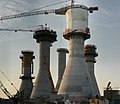| Thorntonbank Wind Farm | |
|---|---|
 Wind turbines D4 (nearest) to D1 on the Thornton Bank | |
 | |
| Country |
|
| Location | 28 km north off the Belgian coast |
| Coordinates | 51°33′06″N2°58′01″E / 51.5516°N 2.9669°E |
| Status | Operational |
| Construction began |
|
| Commission date |
|
| Construction cost | € 1.3 billion |
| Wind farm | |
| Type | |
| Max. water depth |
|
| Distance from shore |
|
| Rotor diameter |
|
| Site area |
|
| Power generation | |
| Units operational | 6 × 5 MW 48 × 6.15 MW |
| Make and model | Senvion 6.2M126 (48) Senvion REpower 5M (6) |
| Nameplate capacity |
|
| External links | |
| Website | c-power |
| Commons | Related media on Commons |
The Thorntonbank Wind Farm (also known as C-Power) is an offshore wind farm. It is the first offshore wind farm in Belgium.
Contents
- Phases
- First phase
- Second and third phase
- Environmental assessment
- Financing
- Gallery
- See also
- References
- External links
Electricity production started in early 2009, with a capacity of 30 MW. The capacity was increased to a total of 214 MW in 2012 and 325 MW in 2013. [1]





